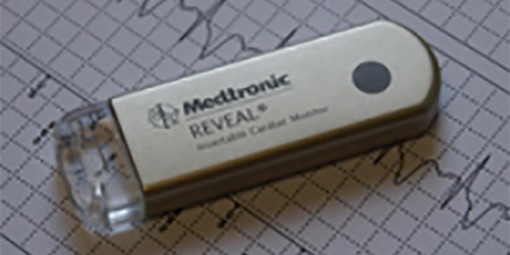Implantable Loop Recorder
In the investigation of recurrent faints or palpitations, repeated monitoring is often used. Unfortunately, these symptoms can be infrequent and be elusive to detection by periodic monitoring with ECG or holter monitors (continuous monitors).
The implantable loop recorder is used to detect these arrhythmias by providing the capability to monitor your heart rhythm for a 1 to 2 year period. This is a small recording device which will be implanted under the skin.

THE PROCEDURE: WHAT IS INVOLVED IN IMPLANTATION OF A LOOP RECORDER?
Insertion of an implantable loop recorder is a very common procedure. This is performed under local anaesthetic with sedative medication to make you feel comfortable. The procedure takes approximately 15 minutes and is performed in the cardiac catheter laboratory. This is a special room that has a patient table, ECG monitors and other equipment. The staff in the lab will all be dressed in hospital theatre clothes and during the procedure will be wearing hats and masks. Many ECG monitoring electrodes will be attached to your chest area. A nurse or doctor will insert an intravenous line usually into the back of your hand. This is needed as a reliable way to give you medications during the study without further injections.
You will also have a blood-pressure cuff attached to your arm that will automatically inflate at various times throughout the procedure. There will also be considerable attention at cleaning the skin under the collarbone where the loop recorder will be inserted. You will also receive antibiotics prior to the procedure. You should ensure that you inform the Doctor if you have any allergies.
The implantable loop recorder is inserted just under the collarbone. The area is prepared with a special sterile solution that may feel cold. A large sterile sheet that will partly cover your face will cover you. You will be able to look out from under the sheet to the side and a nurse will be present at all times. You will be given oxygen to breathe by a small tube that is positioned under your nostrils.
At the start of the procedure, the doctor will inject local anaesthetic into the area under the collarbone where the pacemaker is to be inserted. This will sting momentarily but the area will then be numb. During the procedure you may feel some firm pushing in the shoulder area but this should not be painful. If you experience pain or discomfort you should tell the nurse or doctor. After the procedure you will have some bruising and discomfort in the area of the recorder that may persist for several weeks.
You will be able to go home the same day as the procedure.
RISKS OF IMPLANTABLE LOOP RECORDER
Implantation of a loop recorder is a very common and low risk procedure and should a complication arise, it will be dealt with immediately. Although most people undergoing loop recorder implantation do not experience any complications, you should be aware of the following risks:
- All patients will be left with a scar and a recorder (which can often be felt) under the skin.
- Most patients will have some initial bruising. If you are taking aspirin, clopidogrel, warfarin or other “blood thinners” the bruising may be significant.
- 1 in 100 – An infection may arise at the site. This may require the recorder to be removed.
Obviously every effort is made to minimise the risks of the procedure and you should be aware that emergency equipment is available to deal with any complications that may occur.
